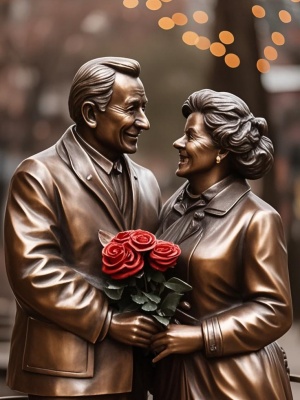The Vibrant World of Pop Art Sculpture: A Modern Artistic Revolution
Introduction: The Rise of Pop Art Sculpture
Pop art sculpture emerged as a groundbreaking movement in the mid-20th century, challenging traditional notions of fine art by incorporating everyday objects and popular culture imagery. This revolutionary art form transformed mundane items into thought-provoking three-dimensional works, blurring the lines between high and low culture. Artists like Claes Oldenburg and Jeff Koons became pioneers, creating oversized sculptures of consumer goods that both celebrated and critiqued modern society.
Key Characteristics of Pop Art Sculpture
Bold Colors and Everyday Objects
Pop art sculptures are instantly recognizable by their vibrant color palettes and use of commonplace items. From giant hamburgers to monumental clothespins, these works elevate the ordinary to extraordinary status. The movement's embrace of commercial aesthetics directly responded to the post-war consumer boom.
Scale and Irony
Many pop art sculptures play with scale to create visual impact and commentary. Oldenburg's large-scale public installations, for instance, transform small objects into architectural wonders, forcing viewers to reconsider their relationship with mass-produced items.
Major Artists and Iconic Works
Claes Oldenburg: Master of the Monumental
Oldenburg's soft sculptures redefined material expectations, while his later large-scale public works like the "Clothespin" in Philadelphia became urban landmarks. His work demonstrates how pop art sculpture can transform public spaces.
Jeff Koons and Contemporary Pop
Koons took pop art sculpture to new heights with his stainless steel "Balloon Dog" series and other reflective works that explore themes of consumerism and kitsch. His pieces regularly break auction records, proving pop art's enduring commercial appeal.
The Problem-Solution Matrix in Pop Art Sculpture
Pop art sculpture addressed several artistic and cultural challenges:
- Problem: Art's elitism vs. Solution: Making art accessible through familiar imagery
- Problem: Mass production devaluing objects vs. Solution: Elevating consumer goods to art status
- Problem: Urban anonymity vs. Solution: Creating playful public sculptures that engage communities
Pop Art Sculpture in the Digital Age
Contemporary artists are incorporating digital technologies into pop art sculpture. Some notable developments include:
- Interactive sculptures using augmented reality
- 3D printed pop art pieces
- Digital installations that reference classic pop art themes
Platforms like MediaAI's art guides demonstrate how AI is influencing new generations of pop-inspired creators.

Conclusion: The Enduring Legacy of Pop Art Sculpture
From its 1960s origins to contemporary digital interpretations, pop art sculpture continues to challenge artistic conventions while remaining deeply connected to popular culture. Its ability to evolve while maintaining core principles of accessibility and commentary ensures its relevance in art history and the commercial art market. As technology advances, we can expect pop art sculpture to continue adapting, offering new ways to engage with the visual language of our consumer society.
For those interested in exploring how modern technology intersects with artistic traditions, AI-powered art tools are creating exciting new possibilities in the pop art realm.
